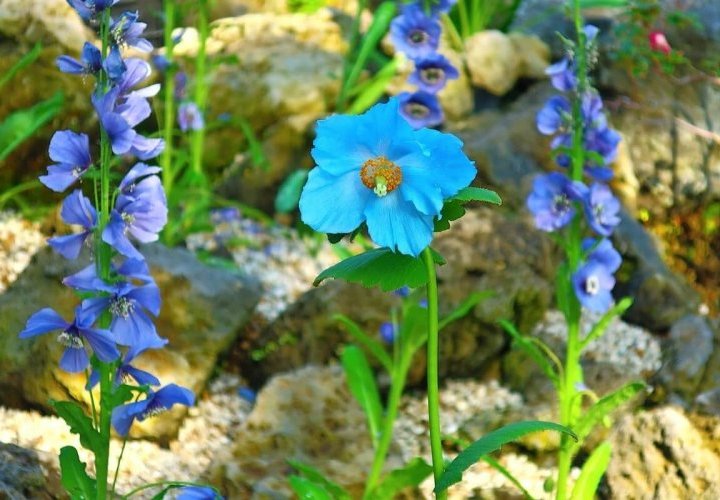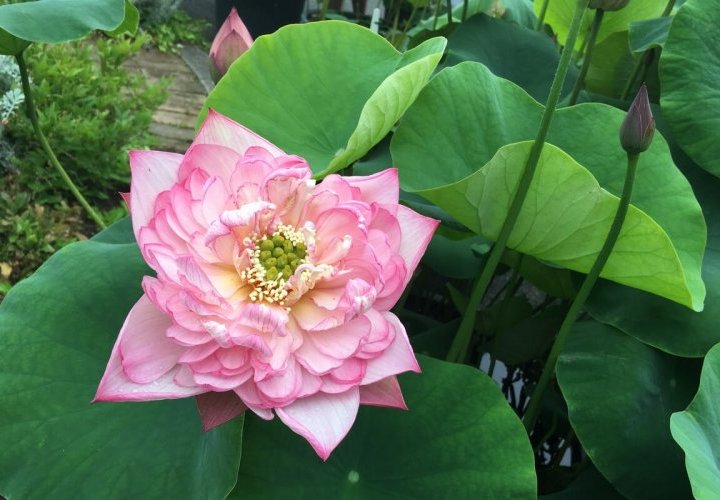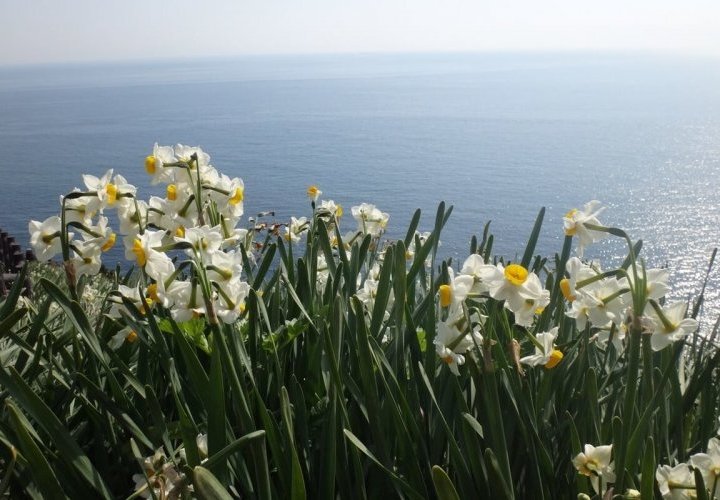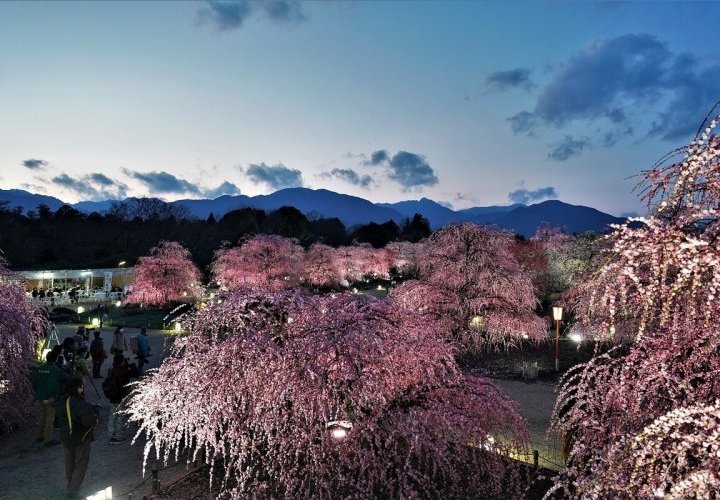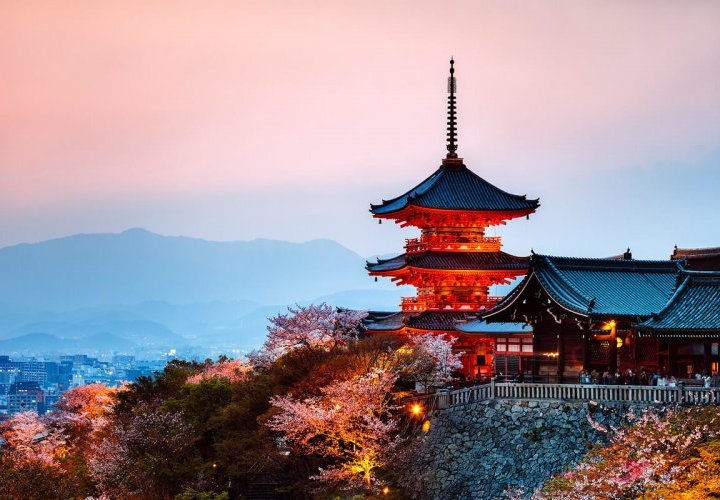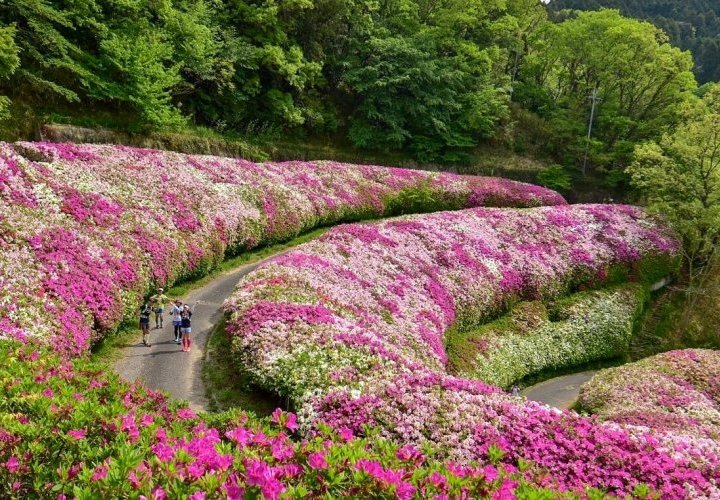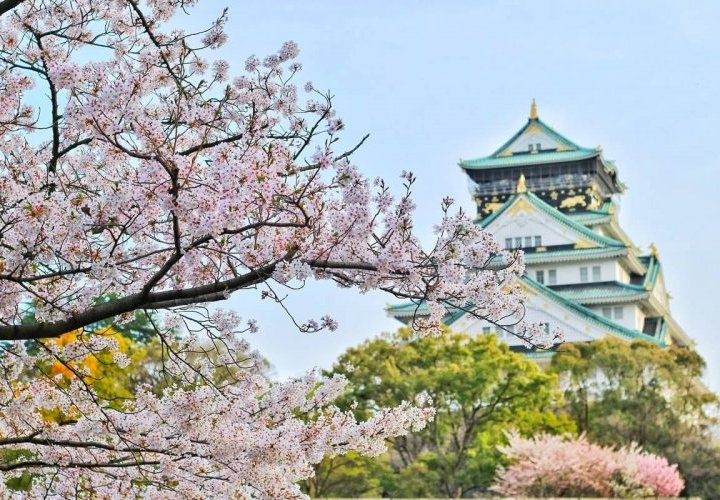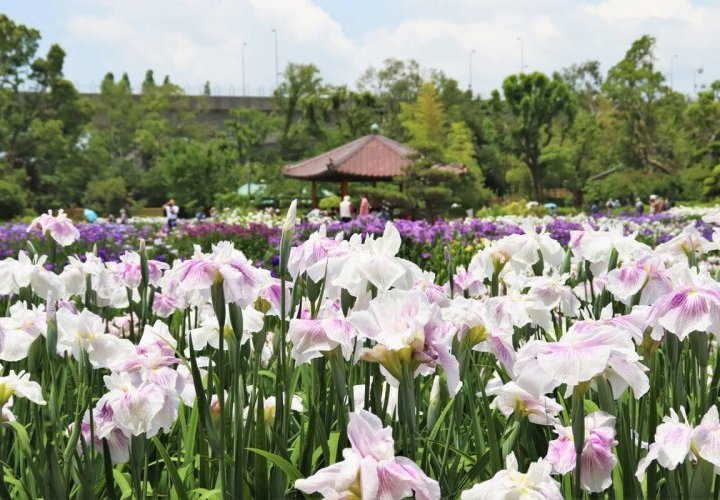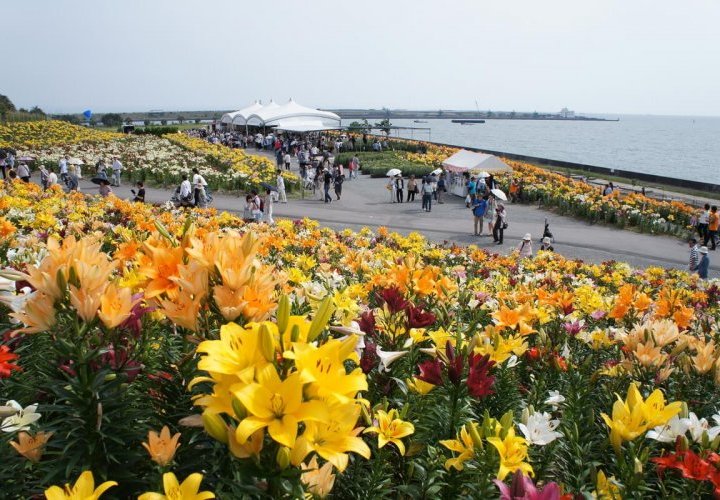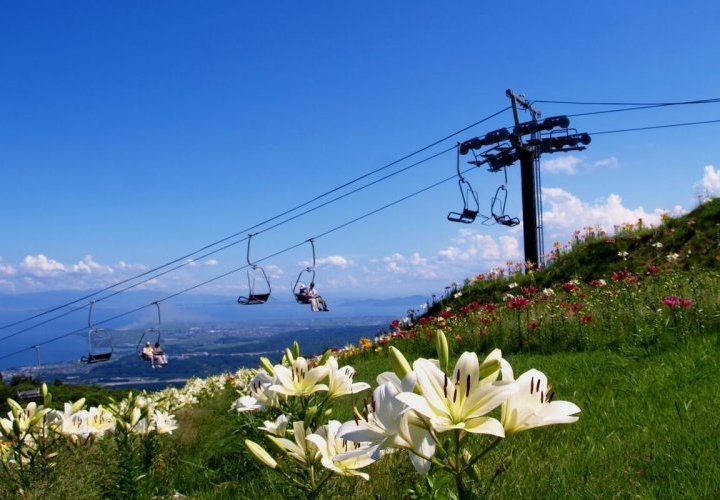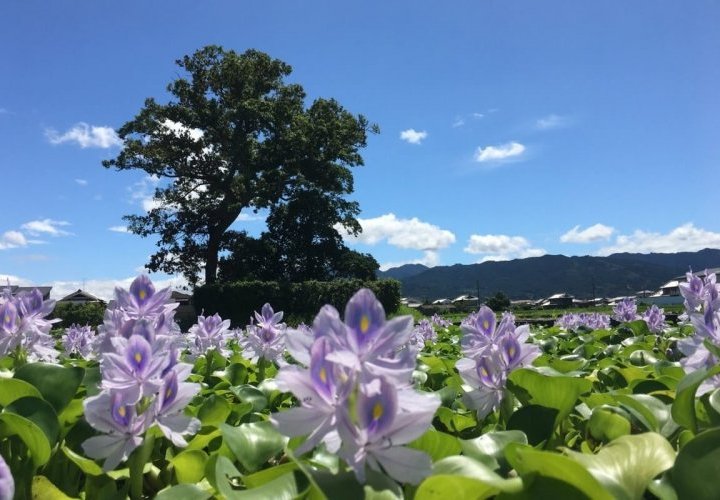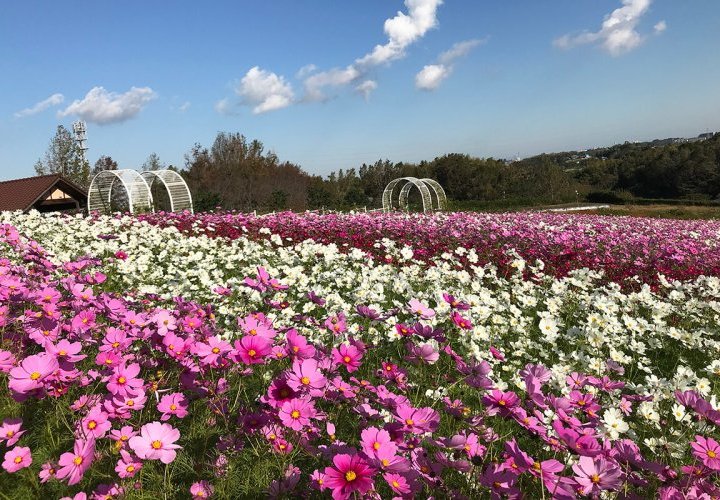Blue poppy and water lily at Sakuya Konohana Kan Garden, Osaka (almost all year round)
Sakuya Konohana Kan Garden is one of the largest nature conservatories in Japan that was built as the main pavilion for Expo '90. The building that looks like a water lily was made out of 5,000 glass panels and is home to 15,000 plants of 2,600 different species, including such rare and precious varieties as the Blue poppy and Victoria water lily of the southern hemisphere. The observatory is a must-see for all flower and plant lovers, who can take in-depth tours around the entire facility accompanied by expert guides and learn about the wonderful nature of our precious planet.
Narcissus (daffodil) in Nada-Kuroiwa Narcissus Field, more
Sakuya Konohana Kan Garden is one of the largest nature conservatories in Japan that was built as the main pavilion for Expo '90. The building that looks like a water lily was made out of 5,000 glass panels and is home to 15,000 plants of 2,600 different species, including such rare and precious varieties as the Blue poppy and Victoria water lily of the southern hemisphere. The observatory is a must-see for all flower and plant lovers, who can take in-depth tours around the entire facility accompanied by expert guides and learn about the wonderful nature of our precious planet.
Narcissus (daffodil) in Nada-Kuroiwa Narcissus Field, more
Awaji (mid-December to mid-February)
Awaji Island, often referred to as the “Island of Flowers”, is one of the best sights for viewing daffodils in Japan. About 5 million wild daffodils bloom in the 7-hectare Nada-Kuroiwa Narcissus Field, which is one of the three greatest natural habitats for daffodils in Japan. If you visit this place, you will enjoy the wonderful contrast of the lemon-yellow daffodils and the blue of the Seto Inland Sea. The daffodils bloom from the middle of December to the middle of February, but the best time to view the flowers is from early January to early February.
Plum blossoms in Minabe-Bairin Plum Orchard Grove, Minabe (late January to early March)
Minabe-Bairin Plum Orchard Grove is one of the biggest plum groves in Japan and is said to offer a view of a million plum trees in bloom, whose aroma fills the air for miles. During the blooming season, the plums in blossom attract crowds of people from around Japan, who come to see the entire mountainside decorated in light-pink colours.
Plum blossoms in Suzuka Forest Garden, Suzuka (mid-February to late March)
Suzuka Forest Garden is home to about 200 weeping plum trees that flourish beautifully here from late February to late March creating a very picturesque scenery. The Suzuka Forest Garden Plum Blossom Festival is held annually at the garden during the season, usually from mid-February to late March, when the plum blossoms are illuminated at night. The best viewing time for plums in bloom is usually from early March.
Plum blossoms at Inabe Plum Grove of the Agriculture Park, Inabe (late February to late March)
Inabe Plum Grove is located within the Agriculture Park in Inabe city, Mie Prefecture and is known as one of the best spots to view plum blossoms in Japan. About 4,500 plum trees of over 100 varieties are planted on an area of 380,000 square metres at the base of the Suzuka Mountain Range. You can enjoy the magnificent view of the colourful plums in bloom with the great mountain in the background. The Inabe Plum Festival is held at Inabe Plum Grove every year during the blooming season, where you can buy delicious plum products such as plum juice, plum jam and plum extract.
Cherry blossoms in Maruyama Park, Kyoto (mid-March to mid-April)
Maruyama Park is known for its 12-metre tall and more than 80-year-old weeping cherry tree that stands out in the middle of the park among other sakura trees. There are about 850 cherry trees of Somei Yoshino and Weeping Cherry varieties. During the cherry blossom season, the parks gets full of people who come here to admire the beautiful cherry trees in bloom. At night, when the trees are illuminated, many people sit under the lit-up trees tasting snacks and drinking beer or sake.
Cherry blossoms at Kiyomizu-dera Temple, Kyoto (late March to early April)
Kiyomizu-dera Temple is a hot attraction even without the cherry blossoms, but this place becomes especially charming when the 1,500 cherry trees (Somei Yoshino and Yamazakura) are in full bloom. The night illumination of the cherry blossoms is considered one of the best in Kyoto and creates a beautiful romantic scenery.
Cherry blossoms at Daigoji Temple, Kyoto (late March to early April)
Daigoji Temple is one of Japan’s UNESCO World Heritage Sites comprising a huge temple complex located in the suburb of Daigo, which lies to the east of Kyoto. The vast temple is renowned for cherry blossoms viewing and is home to over 1,000 sakura trees, including Somei Yoshino, Yamazakura, Weeping Cherry, Yaezakura and Kawazuzakura varieties. The best time to see the flowers in bloom is from late March to early April.
Cherry blossoms in Osaka Castle Park, Osaka (late March to early April)
Osaka Castle Park covers an area of 106.7 hectares and attracts many visitors throughout the year. It is home to over 3,000 cherry trees that blossom from late March to early April and 1,270 Japanese apricot trees blooming from early February to early March. Here, you will enjoy the glamorous panorama of the pink cherry flowers and the green moats of the castle. Nishinomaru Garden of the castle where 600 cherry trees bloom gloriously in spring is illuminated at night during the blooming season.
Cherry blossoms in Kema Sakuranomiya Park, Osaka (late March to early April)
About 4,800 sakura trees grow along the 4.2 km riverbank in the vast Kema Sakuranomiya Park. On the right bank of the Ogawa River, you can find buildings from the Meiji era, such as Osaka Mint Bureau and Sempukan. The park is one of the best places for local residents to walk, run and picnic, especially from late March to early April, when the cherry trees are in bloom.
Cherry blossoms at Hikone Castle, Hikone (late March to mid-April)
Hikone Castle is surrounded by 1,200 sakura trees, which bloom gorgeously from late March to mid-April. The stunning view attracts a flood of visitors during the cherry blossom season, when also various foods and specialities are available. One of the best ways to enjoy the cherry blossoms is by taking houseboats.
Cherry blossoms at Mount Yoshino, Yoshino (late March to late April)
Mt. Yoshino called “Ichimoku Senbon” (a thousand cherry blossom trees in one glance) is home to 30,000 sakura trees that blossom here every spring. The light and dark pink flowers bloom from the foot of the mountain to its peak, mainly in four areas - Shimosenbon, Nakasenbon, Kamisenbon and Okusenbon. There is a viewing platform at Kamisenbon that provides an amazing panorama of the flowers in bloom.
Tulip in Nabana no Sato, Kuwana (late March to late April)
Nabana no Sato is a flower themed park on the island of Nagashima in Kuwana city, Mie Prefecture, about 30 minutes by car from Nagoya. You can enjoy almost 1.8 million tulips of about 200 varieties in the 4-hectare garden. The Tulip Festival, held in the garden from late March to late April, is the most popular event here due to the extraordinary view of the tulips in bloom. At night, when the tulips are illuminated, the view gets even more romantic.
Cherry blossoms in Nara Park, Nara (late March to early May)
Nara Park is a complex where you can see cherry blossoms, deer, temples and shrines. There are about 1,700 cherry trees in the park and the best place to enjoy them in bloom is the lawn near Todaiji Temple. Don’t forget to bring some biscuits in order to take photos both with the flowers and deer.
Cherry blossoms in Yodogawa Riverside Park, Kyoto (late March to early April)
Yodogawa Riverside Park is one of the top cherry blossom viewing spots in Kansai region. The park is located near the border with Osaka Prefecture, at the point of confluence of three rivers: the Katsura River, the Uji River and the Kizu River that merge into Yodogawa River. From late March to early April, about 250 blooming Yoshino cherry trees decorate the 1.4 km riverbank, forming an astonishing pink tunnel. The whole panorama of the cherry blossom tunnel can be seen at Sakura Deaikan Building, which has a 25-metre high observatory deck.
Cherry blossoms at Himeji Castle, Himeji (early April)
As one of the three Japan’s most magnificent castles, one of the first UNESCO World Heritage Sites in the country and top 100 spots to view sakura in Japan, Himeji Castle is always a must-see place, especially during the cherry blossom season. There are 1,000 cherry trees (Yoshino cherry and Weeping cherry) at the grounds of the castle and you can enjoy the spectacular combination of the blue sky, white castle and pink flowers.
Tulip at the Harvest Hill, Sakai (mid to late April)
The Harvest Hill is an agricultural park in Sakai city, Osaka Prefecture, which allows visitors to enjoy a lot of outdoor activities and breathtaking seasonal flower gardens. Over 100,000 tulips of 20 varieties flourish colourfully in the park. They are usually in full bloom from mid-April. The Sakai Tulip Festival is held at the Harvest Hill in April in order to celebrate the beautiful tulips. Besides the colourful tulips on the flowerbeds and fields, you will be able to enjoy various tulip themed hands-on activities.
Azalea in Narukawa Azalea Garden, Ikoma (mid-April to early May)
There are hundreds of thousands of azaleas growing in Narukawa Azalea Garden, which is hidden within Mt. Ikoma. You will be delighted by the vibrant colour of azaleas, which grow in bushes that are higher than yourself. After climbing 1.5 km up from the azalea garden, you will end up in an open space close to the top of the mountain, where you can relax and enjoy the panorama while eating lunch. At the top of Mt. Ikoma, you will find Ikoma Sanjo Amusement Park, where you can catch some views of the Nara Basin and Osaka Plain during the rides.
Wisteria in Shirai Omachi Fuji Park, Asago (late April to early May)
Shirai Omachi Fuji Park is one of the most admired wisteria parks in western Japan and is said to be the greatest wisteria park (wisteria is fuji in Japanese) in Sanin region. On the grounds of the park that has a vast area of 7,000 square metres, you will see a 500 m long and 4 m wide pergola lined with 150 wisteria trees. They usually bloom from late April to early May, creating a spectacular view of beautiful purple flowers.
Awaji Island, often referred to as the “Island of Flowers”, is one of the best sights for viewing daffodils in Japan. About 5 million wild daffodils bloom in the 7-hectare Nada-Kuroiwa Narcissus Field, which is one of the three greatest natural habitats for daffodils in Japan. If you visit this place, you will enjoy the wonderful contrast of the lemon-yellow daffodils and the blue of the Seto Inland Sea. The daffodils bloom from the middle of December to the middle of February, but the best time to view the flowers is from early January to early February.
Plum blossoms in Minabe-Bairin Plum Orchard Grove, Minabe (late January to early March)
Minabe-Bairin Plum Orchard Grove is one of the biggest plum groves in Japan and is said to offer a view of a million plum trees in bloom, whose aroma fills the air for miles. During the blooming season, the plums in blossom attract crowds of people from around Japan, who come to see the entire mountainside decorated in light-pink colours.
Plum blossoms in Suzuka Forest Garden, Suzuka (mid-February to late March)
Suzuka Forest Garden is home to about 200 weeping plum trees that flourish beautifully here from late February to late March creating a very picturesque scenery. The Suzuka Forest Garden Plum Blossom Festival is held annually at the garden during the season, usually from mid-February to late March, when the plum blossoms are illuminated at night. The best viewing time for plums in bloom is usually from early March.
Plum blossoms at Inabe Plum Grove of the Agriculture Park, Inabe (late February to late March)
Inabe Plum Grove is located within the Agriculture Park in Inabe city, Mie Prefecture and is known as one of the best spots to view plum blossoms in Japan. About 4,500 plum trees of over 100 varieties are planted on an area of 380,000 square metres at the base of the Suzuka Mountain Range. You can enjoy the magnificent view of the colourful plums in bloom with the great mountain in the background. The Inabe Plum Festival is held at Inabe Plum Grove every year during the blooming season, where you can buy delicious plum products such as plum juice, plum jam and plum extract.
Cherry blossoms in Maruyama Park, Kyoto (mid-March to mid-April)
Maruyama Park is known for its 12-metre tall and more than 80-year-old weeping cherry tree that stands out in the middle of the park among other sakura trees. There are about 850 cherry trees of Somei Yoshino and Weeping Cherry varieties. During the cherry blossom season, the parks gets full of people who come here to admire the beautiful cherry trees in bloom. At night, when the trees are illuminated, many people sit under the lit-up trees tasting snacks and drinking beer or sake.
Cherry blossoms at Kiyomizu-dera Temple, Kyoto (late March to early April)
Kiyomizu-dera Temple is a hot attraction even without the cherry blossoms, but this place becomes especially charming when the 1,500 cherry trees (Somei Yoshino and Yamazakura) are in full bloom. The night illumination of the cherry blossoms is considered one of the best in Kyoto and creates a beautiful romantic scenery.
Cherry blossoms at Daigoji Temple, Kyoto (late March to early April)
Daigoji Temple is one of Japan’s UNESCO World Heritage Sites comprising a huge temple complex located in the suburb of Daigo, which lies to the east of Kyoto. The vast temple is renowned for cherry blossoms viewing and is home to over 1,000 sakura trees, including Somei Yoshino, Yamazakura, Weeping Cherry, Yaezakura and Kawazuzakura varieties. The best time to see the flowers in bloom is from late March to early April.
Cherry blossoms in Osaka Castle Park, Osaka (late March to early April)
Osaka Castle Park covers an area of 106.7 hectares and attracts many visitors throughout the year. It is home to over 3,000 cherry trees that blossom from late March to early April and 1,270 Japanese apricot trees blooming from early February to early March. Here, you will enjoy the glamorous panorama of the pink cherry flowers and the green moats of the castle. Nishinomaru Garden of the castle where 600 cherry trees bloom gloriously in spring is illuminated at night during the blooming season.
Cherry blossoms in Kema Sakuranomiya Park, Osaka (late March to early April)
About 4,800 sakura trees grow along the 4.2 km riverbank in the vast Kema Sakuranomiya Park. On the right bank of the Ogawa River, you can find buildings from the Meiji era, such as Osaka Mint Bureau and Sempukan. The park is one of the best places for local residents to walk, run and picnic, especially from late March to early April, when the cherry trees are in bloom.
Cherry blossoms at Hikone Castle, Hikone (late March to mid-April)
Hikone Castle is surrounded by 1,200 sakura trees, which bloom gorgeously from late March to mid-April. The stunning view attracts a flood of visitors during the cherry blossom season, when also various foods and specialities are available. One of the best ways to enjoy the cherry blossoms is by taking houseboats.
Cherry blossoms at Mount Yoshino, Yoshino (late March to late April)
Mt. Yoshino called “Ichimoku Senbon” (a thousand cherry blossom trees in one glance) is home to 30,000 sakura trees that blossom here every spring. The light and dark pink flowers bloom from the foot of the mountain to its peak, mainly in four areas - Shimosenbon, Nakasenbon, Kamisenbon and Okusenbon. There is a viewing platform at Kamisenbon that provides an amazing panorama of the flowers in bloom.
Tulip in Nabana no Sato, Kuwana (late March to late April)
Nabana no Sato is a flower themed park on the island of Nagashima in Kuwana city, Mie Prefecture, about 30 minutes by car from Nagoya. You can enjoy almost 1.8 million tulips of about 200 varieties in the 4-hectare garden. The Tulip Festival, held in the garden from late March to late April, is the most popular event here due to the extraordinary view of the tulips in bloom. At night, when the tulips are illuminated, the view gets even more romantic.
Cherry blossoms in Nara Park, Nara (late March to early May)
Nara Park is a complex where you can see cherry blossoms, deer, temples and shrines. There are about 1,700 cherry trees in the park and the best place to enjoy them in bloom is the lawn near Todaiji Temple. Don’t forget to bring some biscuits in order to take photos both with the flowers and deer.
Cherry blossoms in Yodogawa Riverside Park, Kyoto (late March to early April)
Yodogawa Riverside Park is one of the top cherry blossom viewing spots in Kansai region. The park is located near the border with Osaka Prefecture, at the point of confluence of three rivers: the Katsura River, the Uji River and the Kizu River that merge into Yodogawa River. From late March to early April, about 250 blooming Yoshino cherry trees decorate the 1.4 km riverbank, forming an astonishing pink tunnel. The whole panorama of the cherry blossom tunnel can be seen at Sakura Deaikan Building, which has a 25-metre high observatory deck.
Cherry blossoms at Himeji Castle, Himeji (early April)
As one of the three Japan’s most magnificent castles, one of the first UNESCO World Heritage Sites in the country and top 100 spots to view sakura in Japan, Himeji Castle is always a must-see place, especially during the cherry blossom season. There are 1,000 cherry trees (Yoshino cherry and Weeping cherry) at the grounds of the castle and you can enjoy the spectacular combination of the blue sky, white castle and pink flowers.
Tulip at the Harvest Hill, Sakai (mid to late April)
The Harvest Hill is an agricultural park in Sakai city, Osaka Prefecture, which allows visitors to enjoy a lot of outdoor activities and breathtaking seasonal flower gardens. Over 100,000 tulips of 20 varieties flourish colourfully in the park. They are usually in full bloom from mid-April. The Sakai Tulip Festival is held at the Harvest Hill in April in order to celebrate the beautiful tulips. Besides the colourful tulips on the flowerbeds and fields, you will be able to enjoy various tulip themed hands-on activities.
Azalea in Narukawa Azalea Garden, Ikoma (mid-April to early May)
There are hundreds of thousands of azaleas growing in Narukawa Azalea Garden, which is hidden within Mt. Ikoma. You will be delighted by the vibrant colour of azaleas, which grow in bushes that are higher than yourself. After climbing 1.5 km up from the azalea garden, you will end up in an open space close to the top of the mountain, where you can relax and enjoy the panorama while eating lunch. At the top of Mt. Ikoma, you will find Ikoma Sanjo Amusement Park, where you can catch some views of the Nara Basin and Osaka Plain during the rides.
Wisteria in Shirai Omachi Fuji Park, Asago (late April to early May)
Shirai Omachi Fuji Park is one of the most admired wisteria parks in western Japan and is said to be the greatest wisteria park (wisteria is fuji in Japanese) in Sanin region. On the grounds of the park that has a vast area of 7,000 square metres, you will see a 500 m long and 4 m wide pergola lined with 150 wisteria trees. They usually bloom from late April to early May, creating a spectacular view of beautiful purple flowers.
Red azalea at Mount Yamato Katsuragi, Gose (early to mid-May)
The slopes of Mt. Yamato Katsuragi are covered each year in May by thousands of red and pink azaleas in bloom. The beautiful floral carpet contrasting with the blue of the sky and the green of the surrounding trees attracts many hikers and photographers from all over Japan. During the peak season, it is recommended to hike or take the ropeway gondola up Mt. Yamato Katsuragi - both ways offer excellent views of the mountainside. If you go up, you can stay at Katsuragi Kogen Lodge and admire the azaleas from above next morning, when there are fewer people.
Rose in Hamadera Park, Sakai (mid-May to early June; early October to early November)
Located in Sakai city, more
The slopes of Mt. Yamato Katsuragi are covered each year in May by thousands of red and pink azaleas in bloom. The beautiful floral carpet contrasting with the blue of the sky and the green of the surrounding trees attracts many hikers and photographers from all over Japan. During the peak season, it is recommended to hike or take the ropeway gondola up Mt. Yamato Katsuragi - both ways offer excellent views of the mountainside. If you go up, you can stay at Katsuragi Kogen Lodge and admire the azaleas from above next morning, when there are fewer people.
Rose in Hamadera Park, Sakai (mid-May to early June; early October to early November)
Located in Sakai city, more
Hamadera Park was built in 1873 and is one of the largest, oldest and most popular parks in Osaka Prefecture. The park is home to around 5,000 pine trees and was selected as one of Japan’s top 100 great pine tree groves. The Rose Garden was completed in 1993 and is an impressive Japanese circuit-style garden with an area of about 2.5 hectares. About 6,500 rosebushes of 300 varieties, including indigenous Japanese species such as Multiflora Rose (Rosa multiflora) and Rugosa Rose (Rosa rugosa) bloom in the park. The garden allows visitors to enjoy it twice a year, the peak viewing time being from mid-May to early June and from early October to early November. You will be surprised by the sweet fragrance and colourful appearance of the beautiful roses.
Iris in Shirokita Park, Osaka (mid-May to mid-June)
Shirokita Park is not very big, but is definitely one of the best iris parks in Kansai region. There are about 13,000 iris plants of 25 varieties growing in Shirokita Iris Garden of the park. During the blooming season, many people come to the park and bring a light lunch to eat while looking at the flowers.
Lily in Osaka Maishima Yurien Garden, Osaka (late May to early July)
Osaka Maishima Yurien Garden is home to 2.5 million lilies that bloom in a range of colours from late May to early July. The spectacular view of the lovely lilies and the surrounding Osaka Bay make this place a must-visit attraction in Osaka. Near the end of the season, the petals begin to drop, so earlier visits are generally better.
Iris at Otori Shrine, Sakai (early to mid-June)
Iris is the official symbol flower of Sakai city and has been cultivated and improved in Japan since the middle of the Edo period (1603 - 1867). At Otori Shrine you can enjoy 100,000 irises of about 50 species from early to mid-June. The Iris Festival is also held here to celebrate the city’s symbol flower.
Lily in Biwako Hakodateyama Lily Garden, Takashima (early July to late August)
Biwako Hakodateyama Lily Garden is a botanical garden located in Takashima city, Shiga Prefecture. About 2.5 million lilies of 50 different species grow in the garden from early July to late August. The garden has a lift, from which riders can get a bird’s eye view of the flowers and Lake Biwa in the distance. Mt. Hakodateyama is perfect for hiking from spring through fall, but especially in summer when you can see the lilies in bloom. There are also a train, from which you can enjoy the picturesque lilies, a restaurant and a lily plant shop.
Water hyacinth near the ruins of Motoyakushiji Temple, Kashihara (late August to late September)
About 400,000 water hyacinths grow on a 1.4- hectare paddy field near the ruins of Motoyakushiji Temple, a special historical site in Japan located in Kashihara city, Nara Prefecture. The water hyacinth is an aquatic plant with purple flowers that floats on the surface of the water. To the west, you can enjoy the view of Mt. Unebi, which together with Mt. Amanokagu and Mt. Miminashi, were called "Yamato Sanzan" or “the three mountains of Yamato” and designated a Place of Scenic Beauty.
Cosmos at the Harvest Hill, Sakai (late September to late October)
There are about 500,000 cosmos plants blooming at the Harvest Hill on an area of 4,000 square metres from late September to late October. You will be able to enjoy a beautiful contrast of lovely pink, red, and white flowers spreading all over the field and the blue sky.
Iris in Shirokita Park, Osaka (mid-May to mid-June)
Shirokita Park is not very big, but is definitely one of the best iris parks in Kansai region. There are about 13,000 iris plants of 25 varieties growing in Shirokita Iris Garden of the park. During the blooming season, many people come to the park and bring a light lunch to eat while looking at the flowers.
Lily in Osaka Maishima Yurien Garden, Osaka (late May to early July)
Osaka Maishima Yurien Garden is home to 2.5 million lilies that bloom in a range of colours from late May to early July. The spectacular view of the lovely lilies and the surrounding Osaka Bay make this place a must-visit attraction in Osaka. Near the end of the season, the petals begin to drop, so earlier visits are generally better.
Iris at Otori Shrine, Sakai (early to mid-June)
Iris is the official symbol flower of Sakai city and has been cultivated and improved in Japan since the middle of the Edo period (1603 - 1867). At Otori Shrine you can enjoy 100,000 irises of about 50 species from early to mid-June. The Iris Festival is also held here to celebrate the city’s symbol flower.
Lily in Biwako Hakodateyama Lily Garden, Takashima (early July to late August)
Biwako Hakodateyama Lily Garden is a botanical garden located in Takashima city, Shiga Prefecture. About 2.5 million lilies of 50 different species grow in the garden from early July to late August. The garden has a lift, from which riders can get a bird’s eye view of the flowers and Lake Biwa in the distance. Mt. Hakodateyama is perfect for hiking from spring through fall, but especially in summer when you can see the lilies in bloom. There are also a train, from which you can enjoy the picturesque lilies, a restaurant and a lily plant shop.
Water hyacinth near the ruins of Motoyakushiji Temple, Kashihara (late August to late September)
About 400,000 water hyacinths grow on a 1.4- hectare paddy field near the ruins of Motoyakushiji Temple, a special historical site in Japan located in Kashihara city, Nara Prefecture. The water hyacinth is an aquatic plant with purple flowers that floats on the surface of the water. To the west, you can enjoy the view of Mt. Unebi, which together with Mt. Amanokagu and Mt. Miminashi, were called "Yamato Sanzan" or “the three mountains of Yamato” and designated a Place of Scenic Beauty.
Cosmos at the Harvest Hill, Sakai (late September to late October)
There are about 500,000 cosmos plants blooming at the Harvest Hill on an area of 4,000 square metres from late September to late October. You will be able to enjoy a beautiful contrast of lovely pink, red, and white flowers spreading all over the field and the blue sky.

